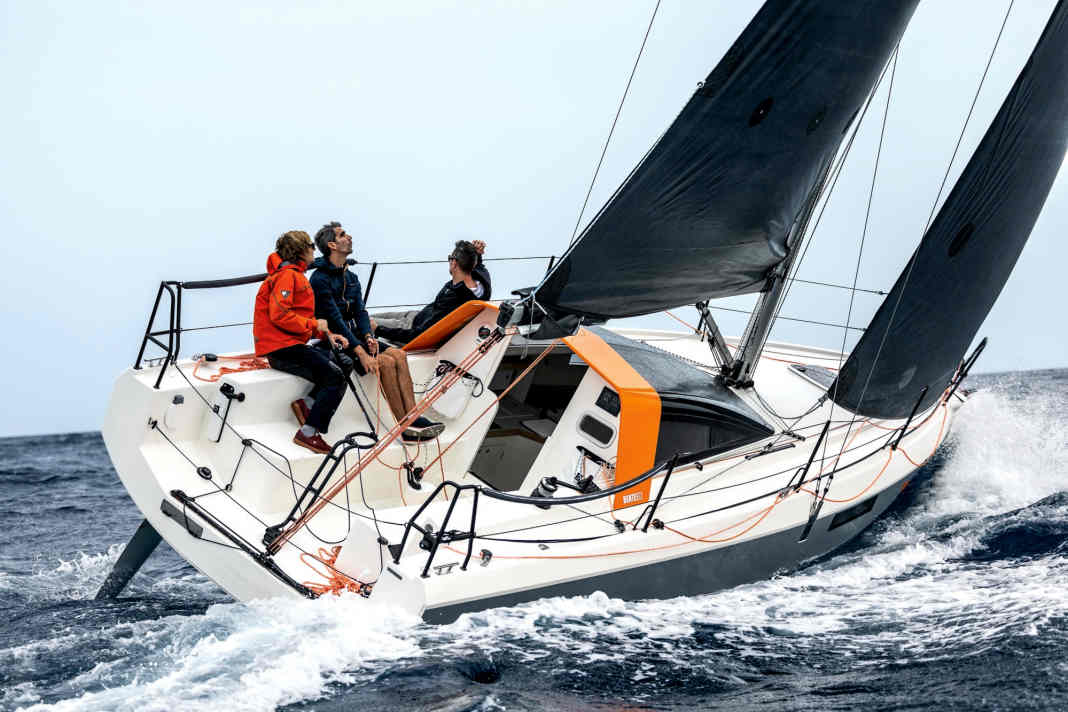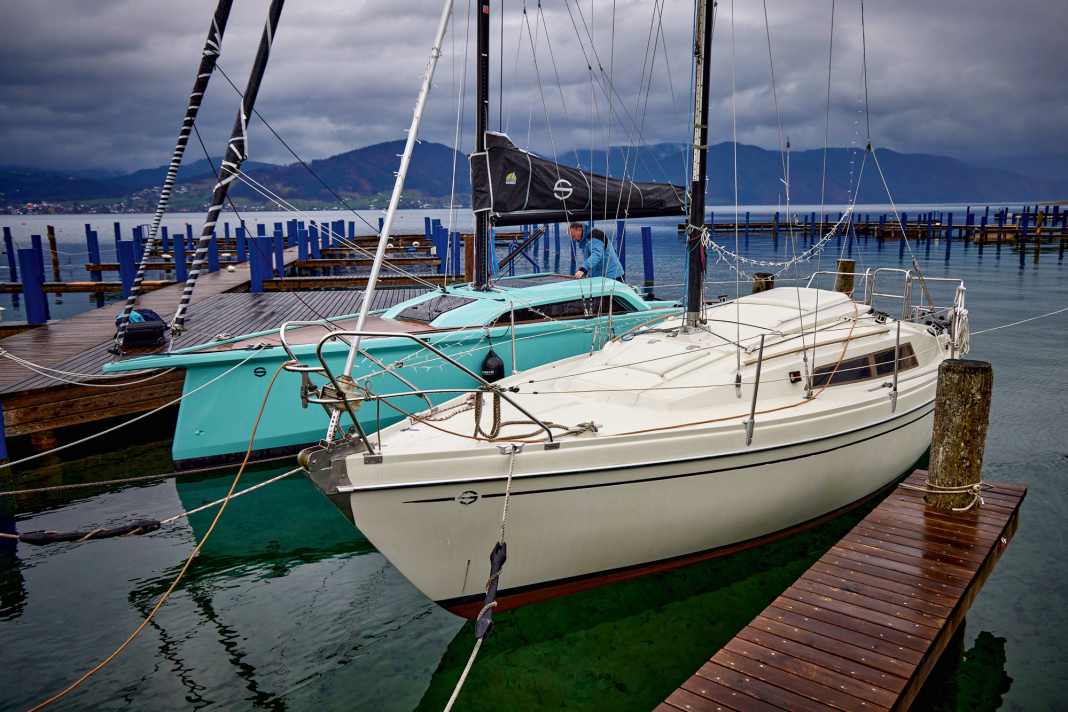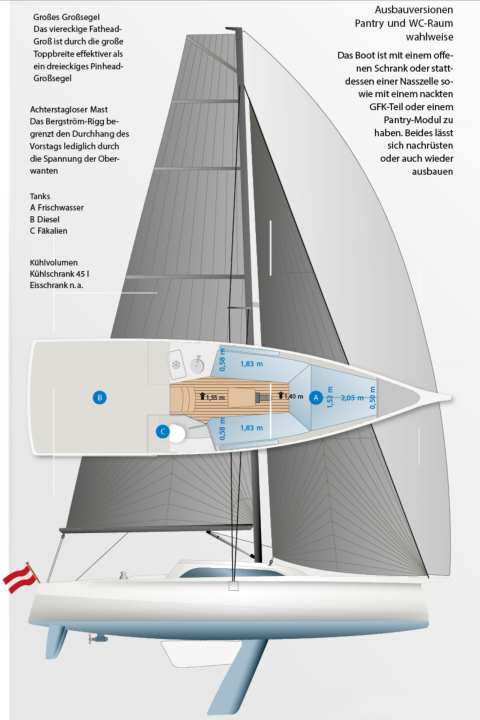





As refreshing as a glacier sweet
There was quite an outcry. When the Austrian Sunbeam shipyard launched the radical Sunbeam 32.1 daysailer in 2021, it caused more discussion than almost any other boat. The negative stem with a protruding deck, the diagonal chines, the superstructure covered by an X-brace and gimmicks such as an electrically extendable cockpit extension. And then there's the colour: café au lait, brown! The provocation was as intentional as it was successful. It also documented the generational change at Schöchl on Mattsee not far from Salzburg, the only boatyard in the Alps for series yachts.
Managing directors Gerhard and Manfred Schöchl, the second generation of the Schöchl family to be in charge since 1990, were in the process of transferring the fate and shares of the shipyard to Manfred's son Andreas. And together with the renowned industrial designer Gerald Kiska, he took up the challenge. For his part, the Salzburg designer lured the family out from behind the tiled stove with a provocation: "Are you brave or are you very brave?" became the rhetorical bon mot for the genesis of the innovative and striking Sunbeam 32.1.
- The big sister in the test: Sunbeam 32.1 dares conceptual triathlon
The yacht also polarised the market, leaving none of its viewers cold. It missed out on the title of European Yacht of the Year in 2022 in favour of more moderate goods. But she sold. 35 units have been built so far.
Sunbeam 29.1 continues on its chosen path - with a de-radicalised design language
The shipyard sees itself on a new and good path. And launched the next new model over a year ago. The Sunbeam 29.1 is similar to its big sister, but de-radicalises the design language. The flight deck, the overhang of the deck in the bow area, is less blatant, the edges and bevelled edges less pronounced, the shape more harmonious, more pleasing, more compatible with mass taste. Compared to the pioneering modern French-style yachts such as the Sun Fast 30 OD, the 29.1 is almost graceful, the hull is moderately narrow at 2.49 metres wide, making the boat easy to trailer. The foredeck is not super-voluminous as is now widespread, the chines are almost delicate and the frame shape is familiar.
Other differences to the Sunbeam 32.1: The smaller boat is steered with a tiller, and the keel can be swivelled as standard, serving draughts between 0.85 and 1.85 metres. There are two short rudder blades to match, guided by solid stainless steel shafts. The rods, the quadrant and the optional autopilot are located outside the hull under a large hatch in the stern and can be accessed by loosening a few screws.
Simple, fast and pretty: the competitors





The swivelling keel offers advantages when slipping and trailering and especially when underway in the water: anchorages can still be found close to the shore in a full bay, and there is no need for a dinghy if you wade to the shore. And shallow moorings are also not an issue. When fully extended, however, the keel provides plenty of lift and, above all, stability. The suspension and mechanics hardly interfere with the boat; on the contrary, the shipyard has refrained from hiding the technology, instead deliberately exposing it - a successful trick. As standard, the crew moves the keel using hand-operated hydraulics; as an option, an electric pump replaces the lever; it is then operated from the outside at the touch of a button. The 800-kilogram keel can be fully raised or lowered in under 30 seconds; a display would be nice to see how far the keel has been extended.
Colour of the test boat polarised, but white is standard
The usefulness of this technical feature is immediately demonstrated during the test in Attersee am Attersee, where construction number one has found its home at the Union Yacht Club on a comfortable but shallow berth far inland. That boat had previously caused a furore at boot Düsseldorf and was the cause of controversy there and in the social media, which was almost more about the colour than the shape. The shape is fixed, the colour of the exhibition and test boat is turquoise green, a mix of blue and yellow in equal parts, with which the gelcoat was dyed. Incidentally, the standard colour is white.
The motor is also worth mentioning. A 4.1 kilowatt pod motor from Aquamot is installed on the shaft as standard. The sensorless three-phase motor flanged under the hull weighs just 21 kilograms and operates at a voltage of 48 volts, powered by lithium batteries with a capacity of 8.2 kilowatt hours. The batteries are easily accessible under a flap in the cockpit, where a small Vetus diesel engine with 12 hp can also be installed as an alternative. The test boat is equipped with the electric motor, which pushes it quietly out of the box.
Sunbeam 29.1 performs incredibly well
And off you go. The mainsail rises electrically from the optional carbon mast with a single pair of spreaders. The rig manages without a backstay, the forestay tension is only generated via the shrouds. Radial fabric from Doyle Austria/Florian Raudaschl comes as standard, the same manufacturer supplies optional upwind cloths made of CDX Cool Grey laminates from Contender (€2,558 surcharge) or Flex from Dimension-Polyant (€5,117). The latter version adorns the test boat.
In any case, the mainsail is designed as an effective fathead, which is made possible by the backstayless rig. The self-tacking jib is furled and wrapped with Facnor's Flat Deck Furler. This is intended to bring the neck of the sail and thus the foot closer to the deck in order to optimise the surface area and reduce pressure exchange. There is still room for improvement on the Sunbeam, the rigging iron is longer than necessary and the shipyard wants to optimise this point.
Details. The big picture is more important. The Sunbeam 29.1 performs incredibly well in light winds. Even at five knots of wind, she gets out of the quark and quickly conjures up values of up to five on the log - on the wind. The gennaker, which has a surface area of 64 square metres and is attached to the 50-centimetre-long, permanently mounted bowsprit at the front, can even reach speeds of 5.5 knots and more over the shiny, leaden water. No real wonder: even downwind, the Sunbeam is extremely well loaded and has a sail carrying capacity of 5.2, which is a ratio of weight to sail area.
Marvellous taming of the Sunbeam 29.1
The counter-test took place on the second test day with 10 to 15 knots of true wind. A very nice 6.5 knots and more were now possible at the cross, although the tacking angle was almost impossible to determine due to the extremely gusty and simultaneously shifting wind. With a furling gennaker again, up to 8.0 knots are possible without wave support, which is easy and relaxed to call up. The good controllability is striking. Even stronger heeling angles are no problem, the boat is visibly stiff and can be tamed wonderfully with the twin rudders. One pull on the tiller and the boat drops willingly, even with a lot of leeway. However, there is no hiding the fact that the double rudder system has a little more friction than the single blade due to the larger number of moving parts and the linkage.
The helmsman sits quite comfortably even when leaning heavily and can support himself with his feet on the tubes that frame the cockpit dents and also serve as a handrail. However, a slightly greater distance between the tube and the dike would be desirable in the area of the helmsman for even better foot support. Without the optional sea railing, the arrangement may no longer fulfil the subjective feeling of safety in stronger winds and, above all, waves.
The mainsheet is designed as a 1:6 jib on the boom clew - which is perfectly adequate - and is led forwards to a flip-flop block with clamp, which is mounted on the floor in front of the tiller and, like the rest of the deck equipment, also comes from Harken. The same applies to the adequately dimensioned 35 mm Performa winches, which have a nice sound.
Great fun even in calm conditions and starts well in windy conditions
The helmsman gets on well with the mainsheet system. What could be improved: the self-tacking jib runs onto the starboard winch, and when there is a lot of heel you wish you could reach the line on each bow. The sheet is led from the rail upwards through the mast downwards and aft. With a double deflection and the line guided accordingly on both sides, the issue would be solved.
To summarise: The Sunbeam 29.1 is great fun for active sailors. It delivers even in calm conditions, yet does not need to be reefed too early, remains under control, starts well, turns quickly and reacts quickly to every gust. The boat has an extremely wide range of usable applications. After all, many cruising boats do not work well below ten knots of wind. The 29.1 will have significantly fewer engine hours than many other yachts of its size.
Cosy enough as a daysailer
The flipside of the rather narrow, flat hull of a sporty boat is usually the interior. On the Sunbeam 29.1, space and comfort are also not the top priority. However, the shipyard has endeavoured to get the maximum out of it here too. The non-separated foredeck contributes to a more generous impression of space. Ambient lighting with many almost vertical light strips creates a special atmosphere. The standard interior is quite empty. A double berth in the foredeck, seamlessly followed by two sofa berths and a GRP moulded section next to the companionway on the port side. Components for a galley can be installed there: a wall unit for storage, a sink with fresh water system, glasses and plates with magnetic holders from Silwy, at an extra cost of 3,451 euros. If required, a refrigerator with compressor can also be added, totalling 1,773 euros.
A wet room can be installed opposite, consisting of a wall, door and chemical toilet, costing 2,142 euros. Good: The room can also be retrofitted if the customer has changed their mind or the boat has been sold, for example.
The most dominant part of the saloon is the centreboard box under the mast support. The shipyard didn't even try to hide it. The linkage and hydraulics technology can be seen openly, but this does not detract from the overall visual impression and conveys a certain technical aesthetic. The saloon table sits on the box and can also be set up in the cockpit with additional supports, a tried and tested solution for smaller yachts.
Sunbeam 29.1 belongs to the ever-growing class of performance luxury daysailers
The bunks are long enough for four people, who also have room at the table, at least for one-armed use of the table top; drinking works, spooning soup too. As expected, there is no headroom inside, the space only has a headroom of 1.40 metres under the superstructure, but you can sit comfortably; from the cushion to under the deck is 90 centimetres, which fits without a hat.
What is missing is storage space. There is little space under the saloon berths, where the service batteries and keel hydraulics are housed, and the water tank at the front. There are no cupboards, lockers or pockets on the walls, which contributes to the open overall impression, but is also somewhat impractical, at least when the crew is on tour. However, equipment, safety equipment, fenders, lines and additional sails can be stored in the large lockers.
All in all, the Sunbeam 29.1 presents itself as a performance luxury daysailer, to use marketing jargon. The segment is larger and more versatile than expected. It includes beauties such as Tofinou and Code from France, the sporty and sophisticated A-Yachts from Austria and the pretty and high-selling Saffier yachts from Holland, to name but a few. What this ever-growing class has in common are attractive, flat boats that sail well - and high prices.
The Sunbeam 29.1 costs just under 150,000 euros in the cheapest version, with a canting keel, sails and electric motor, but still without electronics, electrics, galley and wet room, and desirable features such as ambient lighting, saloon table, rubbing strake or sea railing are not yet on board. But a distinctive sailing finesse is already included in the basic price.
Schöchl: the third generation






In 1957, the Schöchl family's joinery business became a shipyard and Johann and Gottfried started refitting dinghies. In the sixties, the number of units increased with the series production of the corsair dinghy and the Sunbeam 22, one of the most successful small cruisers of the seventies and eighties alongside Dehler's Varianta. Today, the former head of technology, Gottfried's son Manfred Schöchl, advises his son Andreas, who represents the third generation.
Good from experience
The shipyard can look back on many years of experience, many thousands of units and various types. The hulls now come from certified suppliers in Poland, while the construction, outfitting and comprehensive quality control take place in Austria. The shipyard currently builds the keel centreboard Sunbeam 22, the new 29.1, the daysailer 28.1 and the Sunbeam 32.1.
The measured values for testing the Sunbeam 29.1




The Sunbeam 29.1 in detail

Technical data of the Sunbeam 29.1
- Designer: J&J Design
- CE design category: C
- Torso length: 8,50 m
- Total length: 8,99 m
- Waterline length: 7,90 m
- Width: 2,49 m
- Depth: 0,85-1,85 m
- Mast height above WL: 13,00 m
- Theor. torso speed: 6.8 kn
- Weight: 2,3 t
- Ballast/proportion: 0,8 t/35 %
- Mainsail: 30,0 m2
- Self-tacking jib: 17,0 m2
- Electric motor (Aquamot): 4.1 kW
- Diesel (Vetus): 12 HP
- Fuel tank: 40 l
- Fresh water tanks: 80 l
- Batteries Service: 2x 100 Ah/AGM
- Batteries E-motor: 8.2 Ah/lithium
Hull and deck construction
GRP sandwich, manufactured using the hand lay-up method with foam core. Bulkheads glued and laminated, deck-hull connection glued and screwed, glued and laminated floor assembly. Parts of the interior fittings are laminated and contribute to the torsional rigidity. The mast base on deck stands on a GRP support. Double rudder system with roller bearings and stainless steel shafts
Price, equipment and shipyard
- Base price ex shipyard: 148.631 €
- Standard equipment included: engine, sheets, mooring lines, battery, sails, cushions, bilge pump, antifouling
- For an extra charge: Railing and position lanterns € 2,796, compass € 583, galley/cooker/refrigerator € 3,451, WC/wet room € 2,142, sailcloth € 1,309, anchor with chain (only in anchor package with electric winch) € 3,273, fender € 264, fire extinguisher € 60, clear sailing handover € 2,016
- Price ready to sail: 164.525 €
- Guarantee/against osmosis: 2/2 years
Surcharge for comfort equipment
- Hole points: n. a.
- Traveller with line guide: n. a.
- Electric windlass: see above.
- Tube kicker: incl.
- Backstay tensioner: n. a.
- Jumping cleats: 619 €
- Sprayhood: 2.202 €
- Teak in the cockpit (Resysta): Std.
- VHF radio: 2.011 €
- Log and echo sounder: 1.161 €
- Wind measuring system: 1.178 €
- Autopilot: 7.116 €
- Charger/shore connection with RCD: 1.488 €
- 230 volt socket: 209 €
- 12-volt socket: 236 €
- Heating: n. a.
- Pressurised water system: in the pantry package
- Hot water boiler: n. a.
- Cockpit shower: n. a.
- Comfort price: 180.745 €
Included in the price: Resysta in the cockpit, lazy-jacks, furling system, bathing ladder, integrated bowsprit, telescopic tiller jib, hydraulics for swivelling keel
Long nose
An anchor gallows can be moved between the two struts of the trunk. An electric anchor windlass is available as an option
No flap
There is no fold-out or (as on the Sunbeam 32.1) extendable additional surface at the cockpit end, but there is a large sunbathing area, as the dikes do not extend to the stern
Power-saving turning
The self-tacking jib is practical at the cross, but the sail plan needs a supplement on rough courses. A code zero or a gennaker that can also be furled are sensible investments
Top shelf
The test boat came with everything: electric winches, electric motor, electric swivelling keel. Plus sails made from Doyle Flex Sport aramid laminate, navigation electronics and autopilot. And a polarising extra colour
As of 03/2024. How the prices shown are defined can be found here!
Shipyard
Distribution
Dealer network
YACHT review of the Sunbeam 29.1
The Sunbeam 29.1 is an expensive but extremely high-performance daysailer with its own character and many useful options for customised configuration.
Design and concept
- + Independent lines
- + Clear alignment
- + Large cockpit
- + Solid upscale construction
- - High price
Sailing performance and trim
- + Very high performance potential
- + Agile even in light winds
- + Well controllable
- - Jib sheet only on one side
Living and finishing quality
- + Cosy enough as a daysailer
- + Modules for pantry and WC
- - Little interior storage space
Equipment and technology
- + High-quality components
- + Good choice of options
- - No sea toilet from the shipyard

